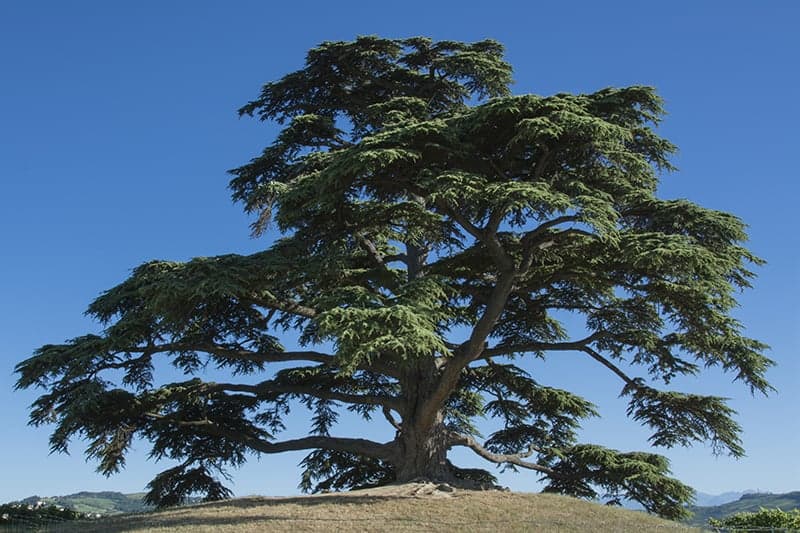- Home >
- Spruce Trees
Spruce Trees for Sale
Do You Know Your Growing Zone? i Growing zones help determine if a particular plant is likely to grow well in a location. It identifies the average annual minimum winter temperatures across the U.S. provided as a map by the USDA.
10 Results
-
Growing Zone(s): 2-6$79.95
-
Growing Zone(s): 2-7$49.95
-
Growing Zone(s): 5-9$19.95
-
Growing Zone(s): 2-8$99.95
$119.95Save up to 16% -
Growing Zone(s): 2-8$154.95
$164.95Save up to 6% -
Growing Zone(s): 2-8$99.95
-
Growing Zone(s): 2-7$29.95
-
Sold OutGrowing Zone(s): 2-7$39.95
-
Sold OutGrowing Zone(s): 2-8$29.95
-
Sold OutGrowing Zone(s): 2-8$129.95
Spruce Trees – Buying & Growing Guide
Spruce trees are members of the genus Picea, which includes about 35 species of trees and shrubs. They are an excellent choice for providing texture in the garden, as well as color that can range from golden-yellow to blue. Although some spruce varieties grow too tall for most gardens, there are a number of dwarf types that make an attractive addition to any landscape.
How to Grow Spruce Trees
How to plant spruce trees
Since spruce trees vary in size depending on the variety (blue spruce, for example, can reach 60 feet), check the tag on your sapling and follow recommendations for spacing if you are planting more than one. Spruce trees like sunny locations with well-draining, loamy soil. They can handle high winds once established, so you can use them as a hedge or windbreak.
Dig a hole two times as wide as the root ball and a little deeper. Mix a little compost, leaf mold, or other organic material into the soil at the bottom of the hole. Place the sapling in the hole so the top of the root ball is even with the top of the soil. Backfill (replace the dirt you removed from the hole) with the compost-enhanced soil.
Once planted, tamp down the soil and water the sapling well. Let the water seep in, then give your tree another drink. If you wish, you can build a low berm a few feet out from the trunk to corral water so the roots can take advantage of it.
How to achieve maximum results
Nurturing your spruce tree when it’s newly planted will yield maximum results in the long term. Site it carefully to take advantage of the sun. Your tree will thrive with six to eight hours of direct sunlight a day. Once planted, you can stake the sapling up with two or three short stakes for the first year or so. This is especially helpful if you’ve planted your tree in a windy site.
How to Care for Spruce Trees
Watering and nutrients
For the first year, water your spruce tree regularly. A good benchmark is one inch of water per week, so if it doesn’t rain that amount, offer it as supplemental watering. When the tree is established and growing robustly, it won’t need as much water, and a full-grown spruce won’t need any watering unless you are experiencing extreme drought.
Spruce trees aren’t heavy feeders. An acidic fertilizer for evergreens, or a fertilizer with fairly high nitrogen, such as 12-6-4, will do for a light feeding in the spring. You can supply many of the tree’s nutrient needs by mulching your spruce with a three to four inch layer of organic matter once a year.
Pollination
Spruce trees are monoecious, meaning that each tree has both male and female flowers, or in this case, cones. Female cones have ovules, while male cones manufacture pollen that gets distributed by the wind to fertilize the female cones. The process of turning that pollen/ovule combination into a seed takes three years, after which the cones drop and release the seeds.
Pruning
Spruce trees don’t need regular pruning. You can prune them for shape in the spring, cutting back branches to a lateral branch or bud. You should also prune off diseased or broken branches when they occur. Eventually, the lower branches may die off and you can remove them to create a cleaner line.
Pests and diseases
Diseases that impact spruce trees include cytospora canker, a fungal disease that can be managed by judicious pruning, and needle rust, another fungal disease that results in needle fall. Spacing trees properly and keeping the area around the trees clean can help with fungal diseases, as can the application of a general purpose fungicide.
Insects that bother spruce trees include the cooley spruce gall adelgid, the Easter spruce gall adelgid, and the spruce spider mite. Adelgids are relatives of aphids and can cause branch die-off and eventually the death of the tree. To control adelgids, spray your spruce with an insecticide in the spring and fall.
Types of Spruce Trees
1. Norway Spruce
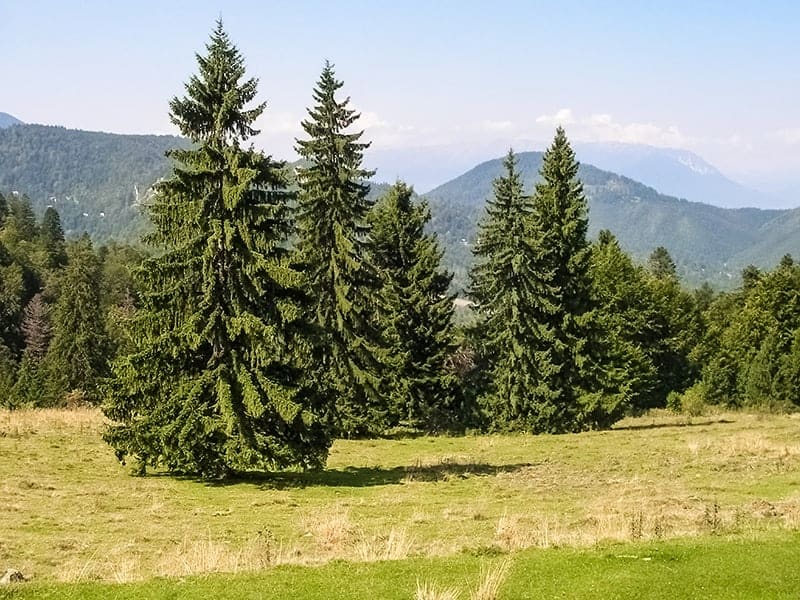
Scientific Name Picea abies
Mature Size: Up to 130 feet tall
Hardiness Zone: 3-8
Light: Full sun
Water: Average moisture needs
Soil: Well-draining, acidic
Cultivars and Varieties: Picea abies ‘Gold Drift’, Picea abies’ Little Gem’, Picea abies ‘Acrocona’, Picea abies ‘Witches’ Brood’, Picea abies ‘Inversa’
This evergreen conifer tree is native to Europe and is sometimes known as the European Spruce. It is a fast-growing tree, typically gaining three feet in height each year for the first 25 years of its life. The tallest Norway Spruce measured in at over 200 feet, but these trees rarely grow to be more than 130 feet. There are many cultivars that have a much smaller height expectancy and are well suited to growing in home gardens, such as the ‘Gold Drift,’ which typically reaches heights of between 12 and 15 feet.
These trees have dense foliage in the form of needle-like leaves that come to a blunt end. The foliage is typically deep green but can vary according to cultivar, with some varieties having lime green or blue-green leaves. The seed cones of Norway spruce trees are quite spectacular and are known to be the largest of any spruce tree, measuring between three and six inches long. The cones are pale brown when mature at around six months of age, but when they first appear on the tree, they are usually a shade of green or red. The ‘Acrocona’ is known for its ornamental seed cones, which are a deep raspberry red color when they emerge on the tips of branches in spring.
These trees are widely cultivated for their softwood and paper purposes. They are also popularly cultivated as Christmas trees and are one of the most common types of trees used for Christmas trees in the world. Norway Spruces are the most widely cultivated type of spruce trees outside of their native habitat and are considered to be among the most commercially important types of conifer trees in Europe. They are easy to grow and are known for being more tolerant of warm temperatures than many other conifer trees, which typically only grow in cooler regions. Norway spruce trees adapt well to a wide range of soils, but they perform best in a well-draining and slightly acidic soil. They have some tolerance to drought when mature but thrive in soil that is evenly moist.
2. White Spruce
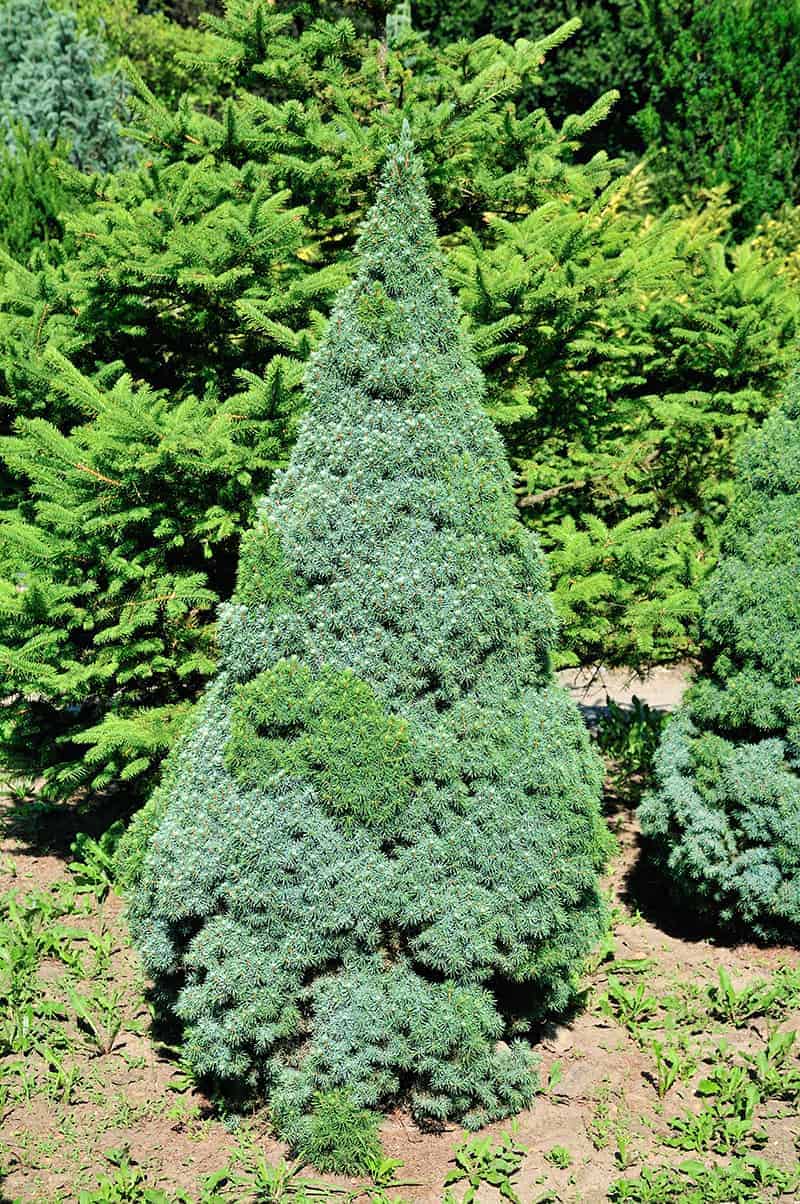
Scientific Name Picea glauca
Mature Size: 120 feet tall
Hardiness Zone: 2-7
Light: Full sun
Water: Average moisture needs
Soil: Well-draining, fertile, acidic
Cultivars and Varieties: Picea glauca ‘Pendula’, Picea glauca ‘Echiniformis’, Picea glauca var. Porsildii (Alaska White Spruce), Picea glauca var. Albertiana (Alberta White Spruce), Picea glauca var. Densata (Black Hills White Spruce)
This evergreen conifer tree is native to North America, from Alaska and across Canada to Newfoundland. It has now become naturalized across many states in the US, including Minnesota, Maine, and Wyoming. It is sometimes commonly known as the Canadian Spruce, or the Alberta Spruce. These trees have an upright growth habit, which forms tall and slender cylinders or lean pyramid shapes. The foliage is needle-like, in deep green or blue-green, and each leaf is typically around half an inch long. The needles are not flattened and instead have a diamond-shaped cross-section. The cones of this tree are cylindrical, generally measuring between one and three inches long. They have a green or red tinge when young but will develop to pale brown several months after pollination.
The trunk of this tree can measure over three feet in diameter when fully grown. It is covered in ornamental bark in a pale shade of gray-brown, and it is thin and flaky, defoliating in round plates. When first exposed, the underneath bark is silver. The White Spruce is the northernmost growing tree in North America, and so it is unsurprising that it is also one of the hardiest types of conifer trees in the world. It is able to withstand extreme winter temperatures as low as −70 °F. It is hardy in zones 2-7, but it will not perform well in hot climates and thrives in zones 3 and 4.
This tree will adapt to a wide variety of soil types, but the quality and condition of the soil play a large part in how well the White Spruce will grow and how able it is to cope with extreme climates. To thrive, this tree needs a well-draining soil that is fertile and slightly acidic. Soil should also be kept evenly moist. When grown in infertile soil, the tree will have much slower growth. White Spruce trees have a good tolerance of drought, but again, when grown in dry soils, they will grow much more slowly. These are tall trees that typically grow to around 100 feet in height, but there are many smaller cultivars available for growing in home gardens.
3. Engelmann Spruce
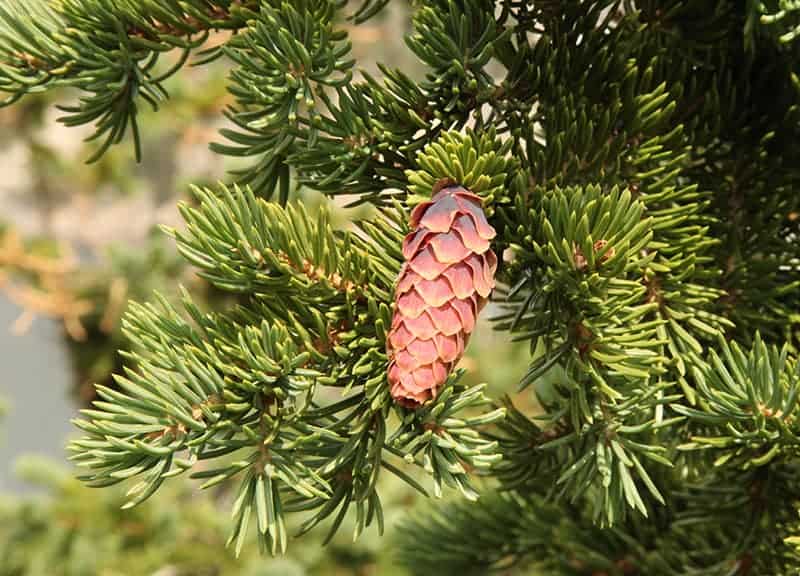
Scientific Name Picea engelmannii
Mature Size: Up to 200 feet tall
Hardiness Zone: 3-8
Light: Full sun
Water: Average moisture needs
Soil: Well-draining
Cultivars and Varieties: Picea engelmannii subsp. Mexicana (Mexican Spruce)
This is an evergreen spruce tree that is native to western North America, from British Columbia in Canada right down to Mexico. Due to the fact that this type of tree is most commonly found growing in its natural habitat at high altitudes, it is also commonly known as the Mountain Spruce. This tree can grow as tall as 200 feet, though it most commonly tops out at around 120 feet. It has a slow but steady growth rate and will continue to grow for as long as 300 years. This tree forms a long and narrow cylindrical shape, with branches that hang at a downward angle to hide its trunk.
The foliage of this tree is stiff and needle-like, with four sides. The leaves are blue-green, with a darker shade on top and a paler shade underneath. The cones of this tree are cylindrical and dangle from the branch tips. They measure around three inches long and are a deep shade of purple when they emerge. After the cones have been pollinated, they develop into a medium brown color. This tree is cultivated for its use in producing paper and for its wood.
Slow growing trees such as this that have been grown at high altitudes have a good resonating quality that makes them ideal for use in producing musical instruments, notably violins, harps, and guitars. The Engelmann Spruce is also sometimes used as a Christmas tree. It should be grown in full sun and thrives in well-draining soils that are moderately moist. It can survive in warm temperatures but will not tolerate high levels of heat and humidity and will fare best in zones 4 and 5.
4. Black Spruce
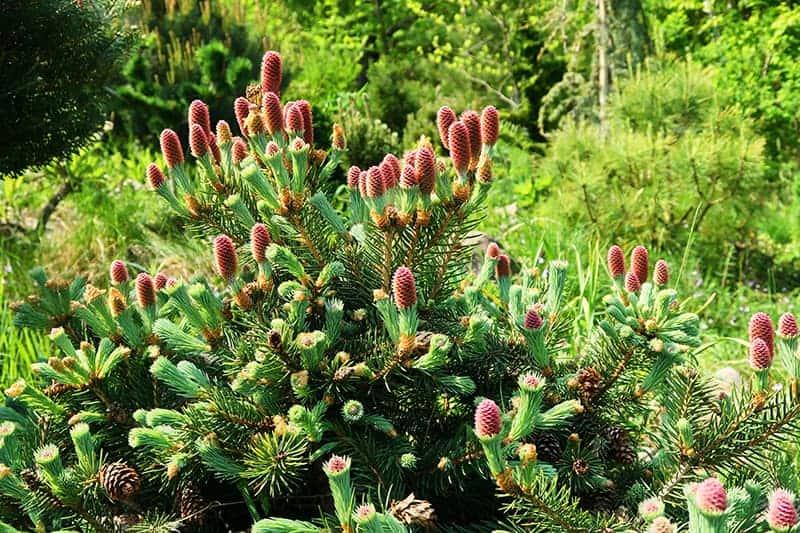
Scientific Name Picea mariana
Mature Size: Up to 90 feet tall
Hardiness Zone: 3-6
Light: Full sun
Water: Average to high moisture needs
Soil: Well-draining, acidic
Cultivars and Varieties: Picea mariana ‘Nana’
This evergreen spruce tree is native to North America, where it is found in all of the Canadian territories and provinces. It is also widespread across the northern portion of the United States. It is commonly found growing in wetlands and is able to cope well in soggy soils and has therefore also earned itself the alternative common names of Bog Spruce and Swamp Spruce.
This is a slow-growing tree, and compared to other types of spruce, it is quite small. Rarely a Black Spruce will grow to over 90 feet in height, but most commonly, these trees range from 20 to 50 feet tall. The ‘Nana’ cultivar is a dwarf form of the Black Spruce that grows to just two feet tall, and it has also been the recipient of the Award of Garden Merit from the Royal Horticultural Society. They form a narrow conical shape, with a scaly gray bark-covered trunk. The branches are descending and are crowded with short and stiff needle-like foliage in a dark blue-green shade.
The pine cones of this tree form in clusters towards the upper half of the tree. They are dark purple at first and develop to a red-brown over time. These cones are some of the smallest cones produced by all spruce trees, and they will hang onto the tree for a few years. Black
Spruce trees are the primary source of pulp for making paper in Canada, but the trees are rarely used for timber due to the small stature of the trees. This tree is the provincial symbol for Newfoundland and Labrador. It grows best in colder climates and can become stressed during hot summers. It thrives in a wide range of soil types, and though it prefers wet or moist soil, it can survive short periods of drought.
5. Colorado Spruce
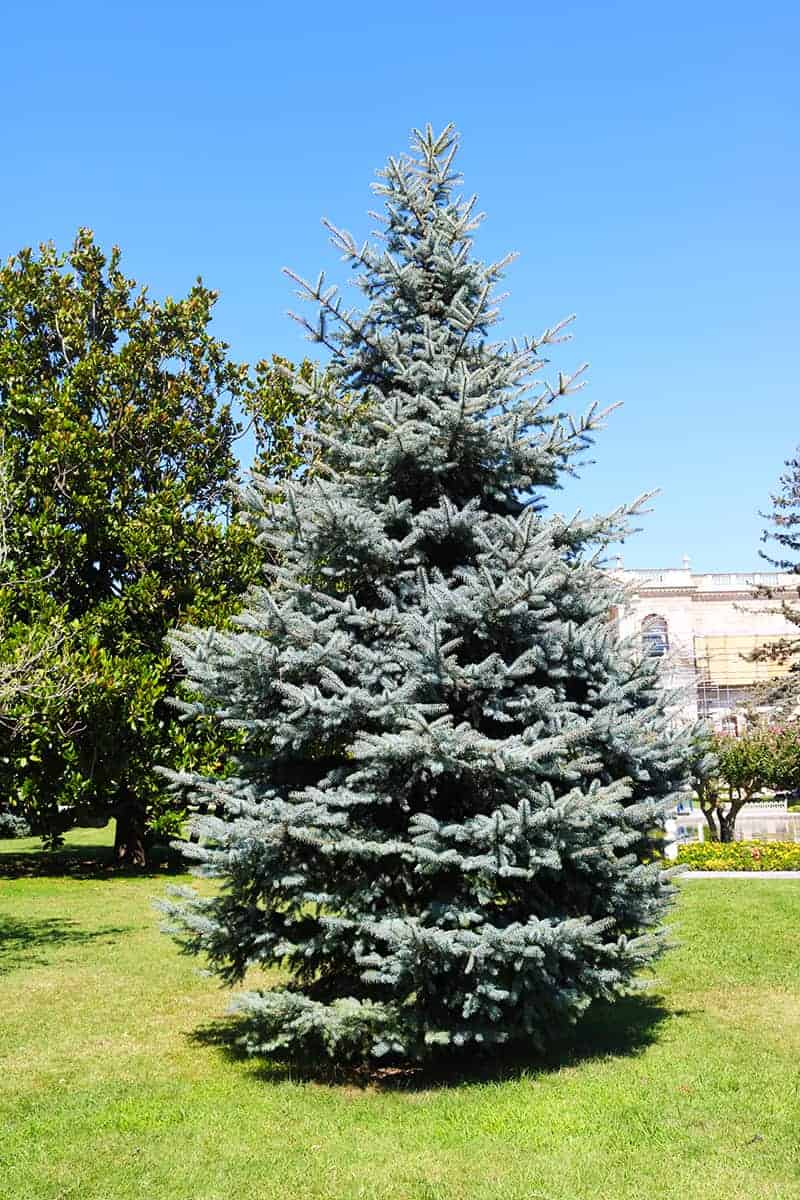
Scientific Name Picea pungens
Mature Size: Up to 75 feet tall
Hardiness Zone: 2-7
Light: Full sun
Water: Average moisture needs
Soil: Well-draining, acidic
Cultivars and Varieties: Picea pungens ‘Edith’, Picea pungens ‘Koster’, Picea pungens ‘The Blues’, Picea pungens ‘Regal Chub’, Picea pungens ‘Baby Blue Eyes’, Picea pungens ‘Mrs. Cesarini’, Picea pungens ‘Glauca Globosa’
This evergreen spruce tree is native to North America, where it is naturally distributed from Alberta and British Columbia all the way down to New Mexico. It has blue-green foliage that has resulted in its other common name of ‘Blue Spruce.’ It is the state tree of Colorado, hence the name ‘Colorado Spruce.’ In their native habitat, these trees can reach over 70 feet in height, but they have been widely cultivated in parks and public spaces outside of their native range, and in these instances, they rarely exceed 50 feet tall. The tree forms a conical shape, with densely packed horizontal branches covered with needle-like foliage that comes to a sharp point.
Most of these spruce trees have blue-green foliage, but there are some cultivars that are strikingly blue, such as ‘Edith,’ which has icy blue needles that stand out vividly in the garden. The cones of these trees are pale brown, usually measuring between three and four inches long. Colorado Spruce trees have shallow roots, yet stand up surprisingly well to wind. They are tolerant of drought but prefer moist, well-draining soils. These trees perform best in cool climates and do not cope well in heat or humidity.
6. Serbian Spruce
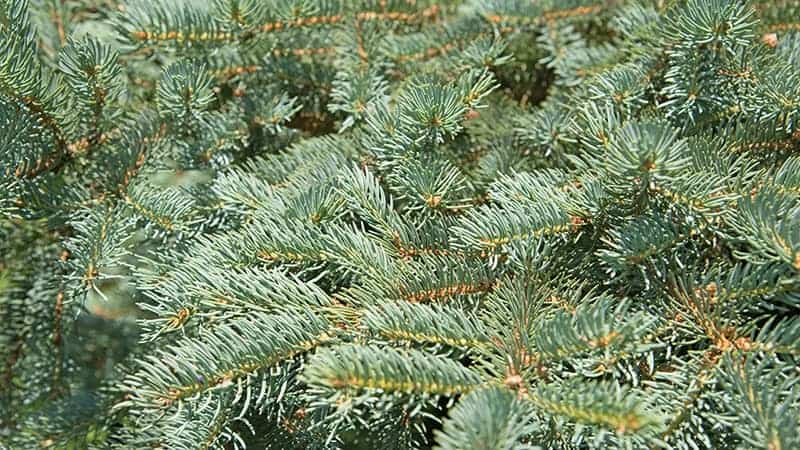
Scientific Name Picea omorika
Mature Size: Up to 130 feet tall
Hardiness Zone: 4-8
Light: Full sun
Water: Average moisture needs
Soil: Well-draining
Cultivars and Varieties: Picea omorika ‘Nana’, Picea omorika ‘Pendula’, Picea omorika ‘Aurea’, Picea omorika ‘Peve Tijn’
This evergreen conifer is native to Serbia and Bosnia, where it is endemic to the Drina River Valley, occurring naturally nowhere else in the world. Its range in this region only covers around 150 acres. Since its discovery in the late 19th century, it has been cultivated across Europe and North America as an ornamental tree. It is noted for its extremely slender shape and its ability to adapt to a wide range of conditions. It is commonly grown in larger gardens and in public spaces, being valued for its lean and graceful look. The branches of the tree are densely packed with blue-green needle-like foliage, which have a flattened shape. The cones of the tree are decorative, being a deep shade of purple on emergence and developing to a dark brown color around eight months after they have been pollinated.
This tree is somewhat cultivated for use as paper pulp or as a Christmas tree, but its slow growth makes it less ideal for these uses than many other spruce trees. It grows best in moist and well-draining soil, but it also adapts well to soil that is sandy, clay, acidic, or alkaline.
7. Sitka Spruce
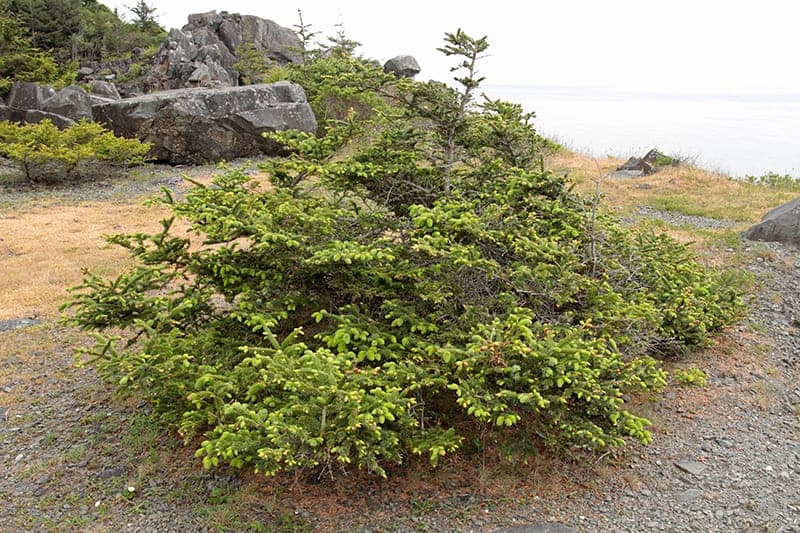
Scientific Name Picea sitchensis
Mature Size: Up to 300 feet
Hardiness Zone: 2-8
Light: Full sun
Water: Average moisture needs
Soil: Well-draining
This evergreen conifer tree is native to the western United States, from Alaska, down through British Columbia, and to the northernmost parts of California. It is named ‘Sitka Spruce’ after the city of Sitka in Alaska, where it is widespread. This is by far the largest of all spruce trees, growing to heights of around 300 feet. It is also considered to be the fifth tallest species of conifer tree in the world. The Sitka Spruce is a fast-growing tree with a long lifespan, with some trees of this type known to be over 700 years old. However, as these trees can gain height quite rapidly, a tall tree is not necessarily the sign of an old tree.
These are truly magnificent trees, with trunks that can span as much as 16 feet in diameter. When young, these trees have a broadly conical shape, but they become more cylindrical with age. They have stiff, sharp, flattened foliage in a needle-like form. The foliage is blue-green, and each needle can measure up to an inch long. The cones of this tree are long and slender, measuring up to four inches in length. They are red or green when they first emerge, hanging from the tree in a pendulus manner. As they mature and undergo pollination, the cones will fade to pale gray-brown. In their native habitat, these trees grow in wet conditions and so perform well in soggy soils, but they also have good adaptability in a range of soil types.
Due to their fast-growing nature, Sitka Spruce trees are widely cultivated for timber. They have been widely planted across the UK and Ireland, where they have naturalized. Sitka Spruce trees now represent over 50% of forest cover in Ireland. It has also been cultivated to a large extent across Norway and Denmark, as it was found to grow more quickly than the Norway Spruce and be more tolerant of salt and wind. However, this tree is now considered to be an invasive species in Norway. Sitka Spruce wood is also popular in producing musical instruments such as violins and guitars, as the lack of knots makes it an ideal sound conductor.












